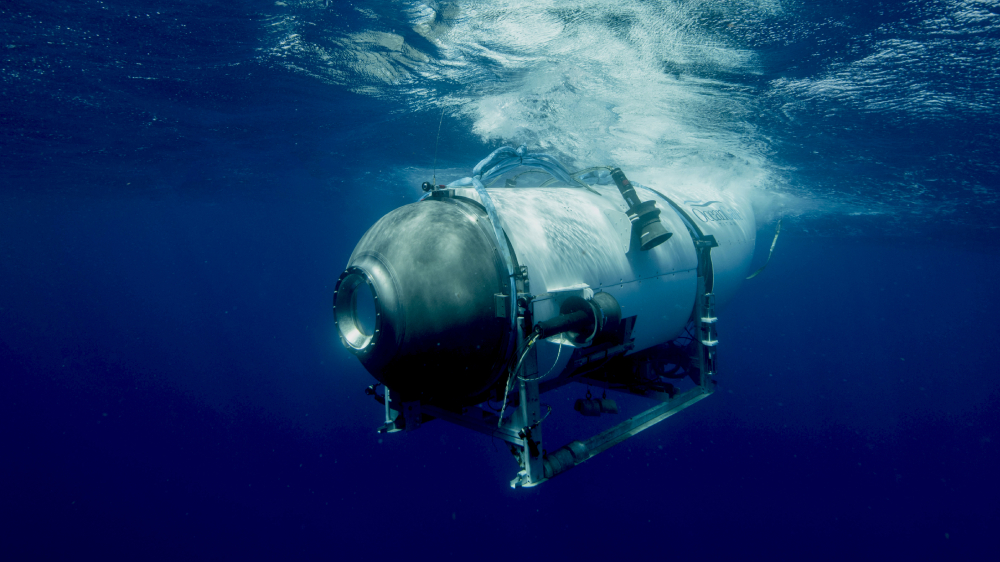Officials are frantically searching for a civilian submersible with five people on board that has gone missing in the North Atlantic while on a voyage to explore the wreckage of the Titanic. News of the vanished submersible first broke out on Monday morning. But here’s the thing: we knew it was bad beforehand.

Rescue teams from the US and Canadian coast guards are battling against the clock, utilizing state-of-the-art technology to scour the vast ocean’s surface and dive deep beneath its chilling depths. Time is of the essence: The fate of those aboard hangs in the balance.
Rear Adm. John Mauger, commander of the US Coast Guard’s First District, remains cautiously optimistic, revealing that the vessel has anywhere between 70 to 96 hours of life support available. However, time is quickly slipping away.
It’s not clear what the crew’s odds of survival are. They may have less than 48 hours of oxygen left. The people onboard include a pilot and four paying passengers, who each paid $250,000 to have the privilege of getting stuck in a steel coffin deep beneath the sea.
The Titanic wreck tourists include:
- Hamish Harding, a British businessman and explorer. He holds several Guinness World Records, including one for the longest time spent traversing the deepest part of the ocean on a single dive, and had previously flown to space with Blue Origin.
- Paul-Henri Nargeolet, a French maritime expert. He has extensive experience diving at the Titanic wreck site, which he’s visited over 35 times, and is the director of underwater research for RMS Titanic, Inc.
- Shahzada Dawood and his son, Suleman Dawood, were also on the missing submersible. Shahzada Dawood is a British businessman from a wealthy Pakistani family, who is also involved with the Search for Extraterrestrial Intelligence Institute (SETI).
The submersible is operated by an ocean tour company called OceanGate. The trip was meant to take the crew to see the Titanic wreck up close, located some 435 miles (700km) south of St John’s, Newfoundland, and at a depth of 3,800m (12,500ft).
Each full dive to the wreck, including the descent and ascent, reportedly takes around eight hours.
However, Chief Mi’sel Joe of Miawpukek First Nation, which co-owns the Polar Prince, the support vessel on the expedition, said he received a call Sunday afternoon alerting him the sub was two hours overdue and still hadn’t surfaced. They had also lost communication with the sub, according to CNN.
A titanic disaster
The submersible in question is a 21-foot, 23,000-pound vessel called Titan. According to OceanGate, Titan is the only deep-sea vessel in the world capable of carrying five people to depths greater than two and a half miles beneath the ocean’s surface.
The sub is made of carbon fiber and coated in titanium. It allegedly uses a “proprietary real-time hull health monitoring (RTM) system”, OceanGate says.
It has a number of other features, which I won’t bother to list in full here. What you need to know is that this submersible is a piece of junk.
Last summer, CBS “Sunday Mornings” correspondent David Pogue actually went on a trip to the Titanic wreck on this thing. He described it as a “one-of-a-kind submersible craft” but also found the whole thing nerve-wracking. I mean, just look at this segment below.
To make matters even worse, the company skimmed on safety measures — something which could seal the passengers’ fate.
A bolt-sealed drainage pipe
Pogue noticed that some of the equipment on the Titan sub looked as if they were “improvised”. Indeed, an OceanGate crew member boasts that he “got these from Camper World”, pointing to a handle. The whole sub is controlled by a $30 Logitech game controller. There are a number of other off-the-shelf parts. Not exactly what you want when you’re under the crushing pressure of the deep sea. But it gets even worse.
There’s just a tiny viewport which you can use to peak to see outside. The passengers paid for the privilege of risking their lives just to be physically up close to a 100-year-old wreck covered in plankton. There’s a display screen that relays video captured by a camera, but they could have just watched the video feed remotely from a ship.
Oh and by the way, the crew is sealed inside the vessel by bolts applied from the outside.
“There’s no way to escape, even if you rise to the surface by yourself. You cannot get out of the sub without a crew on the outside letting you out,” said Pogue, who must be shacking furiously right now. It could have been him right now stuck inside some god-forsaken piece of junk with a gazillion tons of water above his shoulders.
This is what it looks like inside.

All the passengers had to sign a lot of paperwork, including a contract that reads “This experimental vessel has not been approved or certified by any regulatory body, and could result in physical injury, emotional trauma, or death.”
It’s not clear whether this is enough to let the company off the hook. In the meantime, however, the search continues, and hope still exists for the unfortunate passengers.






